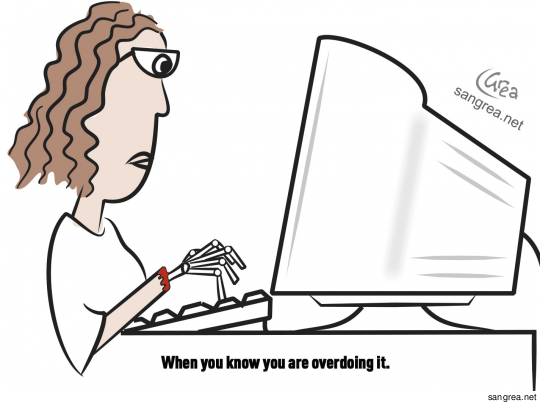
February 29, 2012, is International RSI Awareness Day, dedicated to helping workers avoid repetitive strain injuries. Originally organized in Canada in 2000, RSI Awareness Day is observed on the last day in February – which, thanks to leap years, is the only “non-repetitive” day on the calendar.
For university employees, it’s a good time to assess whether the way you use a computer may put your health at risk – and if so, to make some changes.
RSI and COMPUTER WORK
Use of a computer keyboard and/or mouse can lead to persistent muscle aches, tendon inflammation, nerve compressions, and subsequent impairments that in some cases may be long-standing. At a large university, hundreds of people a year may be affected by such problems due to overuse and/or misuse of computer workstations.
The musculoskeletal system is built to have periods of activity alternating with periods of rest that allow recovery and renewal. Working at a computer long hours subjects certain parts of the body to static postures while other parts move incessantly. Both static postures and constant activity can cause first microscopic and then macroscopic damage to biologic tissues.
There are four keys to RSI prevention: pacing, position, technique, and exercise.
PACING
Introduce breaks in your typing to permit recovery and restoration, and do this at a frequency that does not allow pain or discomfort to develop. No schedule of typing and rest breaks is universal, but as a general guideline:
*Take a 1 or 2 minute “micro break” every 10 to 15 minutes.
*Take a 5 to 10 minute “mini break” every hour.
*Every few hours, get up and do some alternative activity.
*Using a timer or other automatic reminder is helpful to make sure that you take breaks at these intervals rather than waiting for fatigue or discomfort. During breaks, do stretches to relax muscles. Consider using typing break software, such as Stretch Break or similar programs.
POSITION
Adjust your workstation to minimize the awkwardness and stress involved in keyboard activity:
*Use a telephone headset instead of cradling the phone between ear and shoulder.
*Rest feet on the floor or on a footrest, support thighs with a soft chair, and support the lower back.
*Let upper arms hang loosely from the shoulder, extend forearms horizontally toward the keyboard, lower and angle keyboard slightly away (negative pitch) so the wrists are in a neutral position, with mouse next to the keyboard at the same level. Do not lean wrists on any surface (including a wrist rest) while typing or using the mouse.
*Center yourself in front of a glare-free monitor; keep at a comfortable distance from the monitor, looking down at a 10 to 30 degree angle.
TECHNIQUE
Use a typing technique that does not traumatize the fingers and wrists but rather involves movement of the arm as a whole. Typing technique should emphasize fluid movement of the arms to avoid angling the wrists forward, back, or side-to-side. Press the keys lightly. When not actively typing, rest hands, thumbs up in your lap (“neutral posture”) rather than resting them on a pad or the keyboard edge. When a command requires key combinations, use two hands to avoid contorting the hand. Use software programs allowing “sticky keys” and macros whenever possible. An alternative keyboard and/or pointing device (to replace the standard mouse) may benefit some individuals.
EXERCISE
General aerobic exercise, done regularly, will sustain strength, improve cardiovascular conditioning, and quicken recovery from sedentary computer use. Also learn to do a series of stretches during rest breaks that restore health and vitality to your body. As a general rule, none of these should involve movement outside the range of motion and nothing should be done that hurts. The purpose of stretching is to relax muscles and improve circulation. Arm strengthening should not be emphasized.
WHAT NOT TO DO
Routine use of medication or braces is not recommended. If you have questions about these recommendations or begin to develop symptoms, you should seek further information or medical evaluation. Slight adjustments now may avoid future complications in many cases!
RESOURCES
*Assistive Technology Information Center
*Cornell University Ergonomics Web [See links in center, under “Computer Workstation Guide.”]
*Repetitive Strain Injury: A Computer User’s Guide (Pascarelli & Quilter, Wiley 1994)
*For medical advice, see your physician or contact the Mount Sinai-Irving J. Selikoff Center for Occupational & Environmental Medicine.
*The PSC Health & Safety Watchdogs can arrange a group training on computer use at your campus.
______________________________
Dr. David Diamond is an internist, a specialist in occupational and environmental medicine, and an instructor at Harvard Medical School. Prepared in conjunction with the Assistive Technology Information Center.

